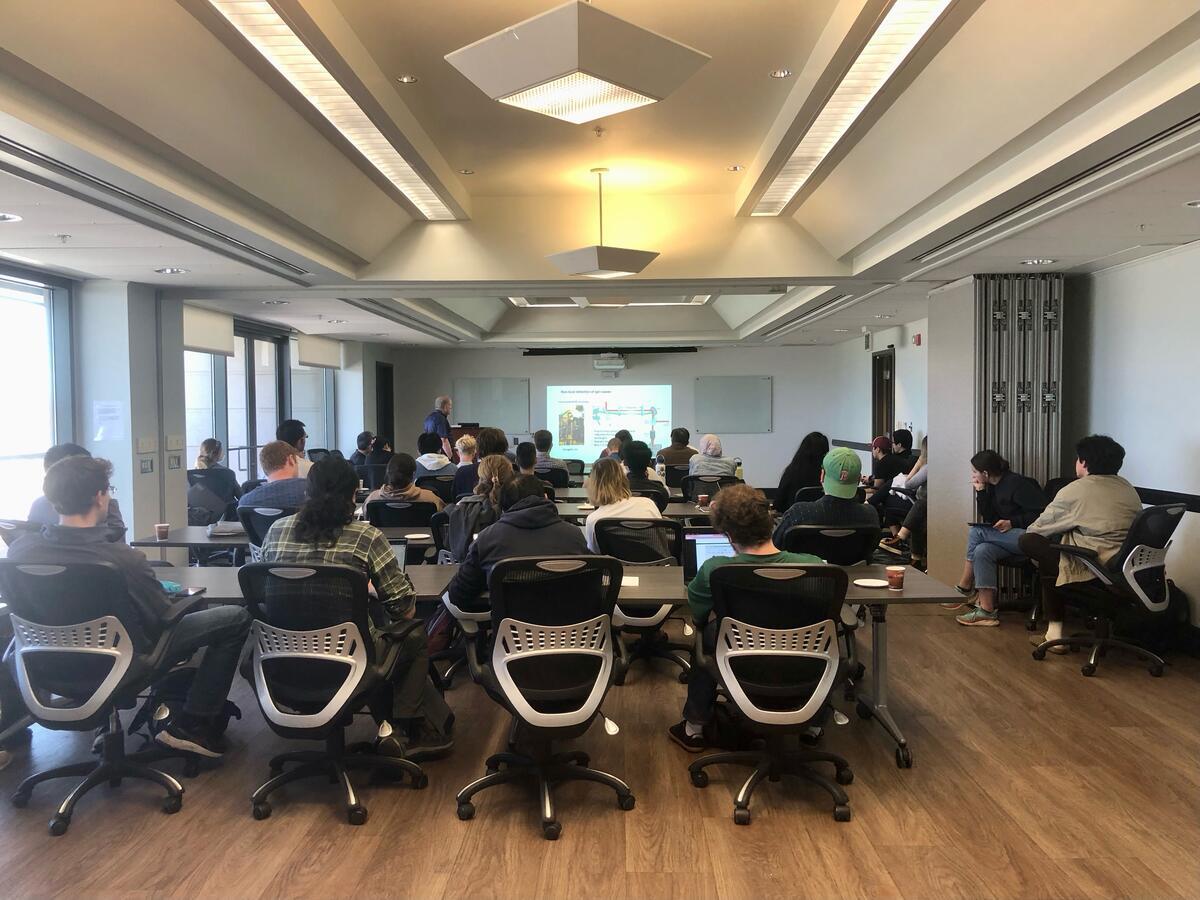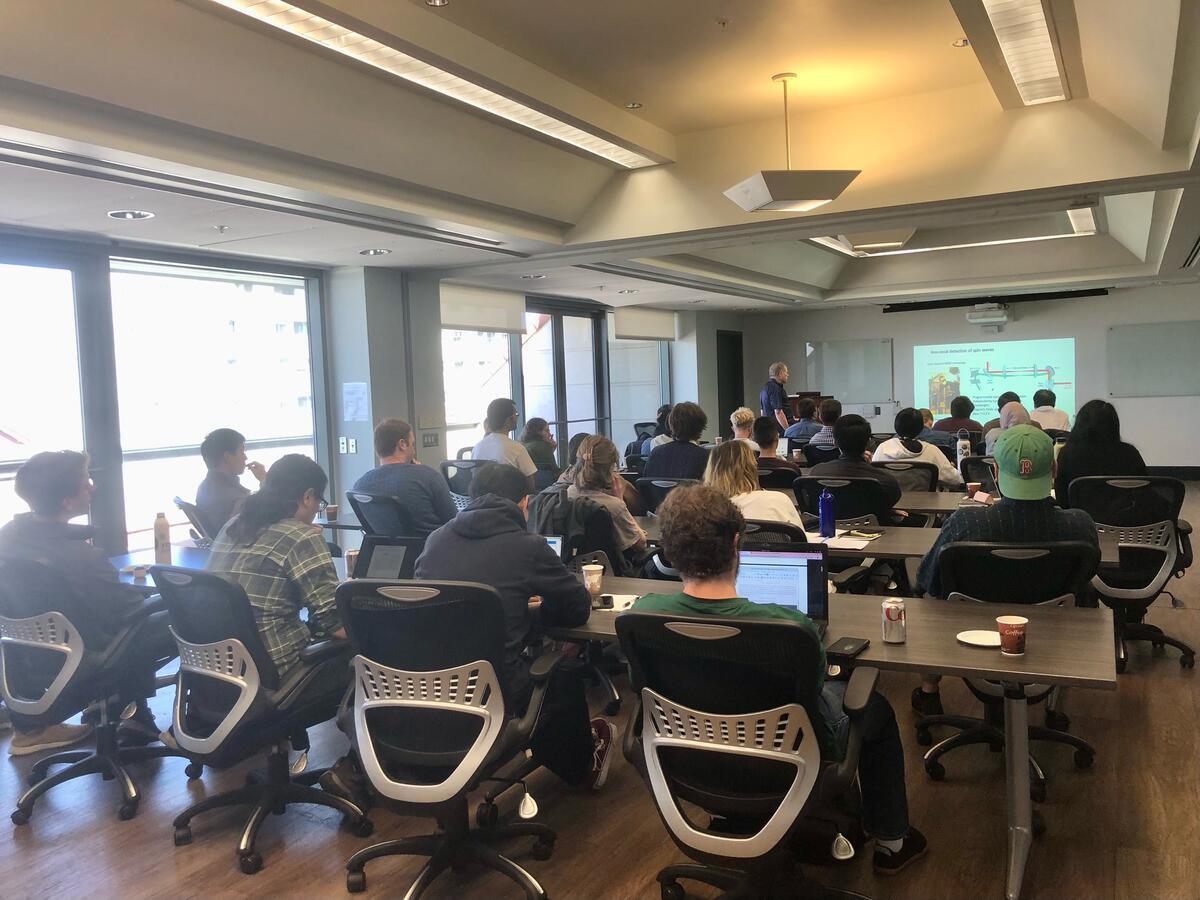| 08:30 - 08:45 a.m. | Continental Breakfast |
| 08:45 - 09:00 a.m. |
Welcoming Remarks Hossein Taghinejad, Kavli / Heising-Simons Junior Fellow |
| 09:00 - 9:45 a.m. |
Yuri Suzuki, Professor of Applied Physics and MSE, Stanford University "Spin Waves in Low Loss Ferromagnetic Insulator Materials"
Abstract: Spin functionality in materials has the potential to transform energy relevant technologies by providing a new approach to information propagation and manipulation. It has been exploited to a limited extent in microelectronics via the flow of spin-polarized charge current. However, more recently, pure spin currents based on the flow of angular momentum via spin waves, or magnons, have been identified as a new medium for information propagation and manipulation. A spin-wave-based electronics based on ferromagnetic insulators where information can be transported and manipulated without charge current would provide a new paradigm for low energy consumption computing. However, insulating behavior is not a sufficient requirement for low damping, as shown by the very limited options for low-damping insulatorsWe have developed a new class of low loss spin ferrite thin films with Gilbert damping parameter as low as ~ 0.0006 and negligible inhomogeneous linewidth broadening, resulting in narrow half-width half-maximum linewidths. The most promising spinel ferrite films are of the compositions Mg(Al,Fe)2O4 and Li0.5(Al,Fe)2.5O4 some of which can be grown with perpendicular magnetic anisotropy. We have also demonstrated efficient spin pumping from these spinel ferrites into an adjacent heavy metal layer as well as spin wave control and detection. Spin-torque ferromagnetic resonance measurements indicate that we can indeed achieve electrical control of magnetization. Current induced spin-orbit torque switching of the ferrite magnetization is repeatable and reversible with spin-to-charge interconversion in Pt that is significantly larger than previous studies. This new class of epitaxial spinel ferrite materials is promising for future low-power electronics such as spin-wave logic devices, voltage controlled magnetic memory and magnonic waveguides. Biosketch: My experimental group focuses on novel ground states and functional properties in condensed matter systems synthesized via atomically precise thin film deposition techniques with a recent emphasis on highly correlated electronic systems:. Many of these phenomena are then incorporated into prototypical device structures. Our recent focus is on: emergent interfacial phenomena electronic and magnetic phenomena, spin current generation, propagation, and control in complex oxide based ferromagnets strongly correlated materials, multifunctional behavior in complex oxide thin films and heterostructures, low dimensional electron gas systems. |
| 09:45 - 10:30 a.m. |
Yuan Ping, Associate Professor of Chemistry and Biochemistry, UC Santa Cruz "Ab Initio Open Quantum Dynamics for Spin and Electron Relaxation in Solids"
Abstract: Designing new quantum materials with long-lived electron spin states is in urgent need of a general theoretical formalism and computational technique to reliably predict spin relaxation and coherence times. We present a new, universal first-principles methodology based on density matrix (DM) dynamics for open quantum systems to calculate the spin relaxation and decoherence time of solids with arbitrary spin mixing and crystal symmetry[1]. Through the complete theoretical descriptions of pump, probe and scattering processes including electron-phonon, electron-impurity and electron-electron scattering with spin-orbit coupling, our method can directly simulate the pump-probe measurements for coupled spin and electron dynamics and ultrafast Kerr rotation[2], and is applicable to any temperatures and doping levels, under external electric[3] and magnetic field[5]Our ab initio predictions are in excellent agreement with experimental spin lifetime for a broad range of materials[1,2]. We further apply our method to investigate the condition of realizing spin-valley locking and long spin lifetime of 2D Dirac materials[3], as well as manipulation of spin-orbit fields and spin relaxation through substrate proximity effects[4]. We will finally show how g factor fluctuations lead to spin dephasing in halide perovskites under external magnetic field[5]. Biosketch: Yuan Ping received her B.Sc. degree from University of Science and Technology of China (USTC), in 2007 and her Ph.D. from UC Davis under Giulia Galli (currently at U. Chicago) in 2013. She was a materials postdoctoral fellow in JCAP at Caltech from 2013 to 2016, under the supervision of William Goddard III. In 2016 summer, she joined the faculty at UC Santa Cruz as an assistant professor in Chemistry department and affiliated professor in physics department. Ping made important contributions on developing many-body perturbation theory with efficient numerical methods, in particular solving Bethe-Salpeter equation without empty states for solids with her coworkers during her PhD. She worked on charge transfer and catalytic properties at solid/liquid interfaces and polaronic transport in doped oxides during her postdoc and afterward. Now she moved to a new direction of developing quantum dynamics for spin and exciton from first-principles, designing new materials for quantum information science. Ping has authored more than 40 peer-reviewed publications including Nature Materials, Nature Communications, Phys. Revs., JACS, Chem. Soc. Rev. where she was the sole or co-corresponding author. She was a recipient of Nature Research award in 2020 and Hellman fellows in 2018. References [1] J. Xu, A. Habib, S. Kumar, F. Wu, R. Sundararaman, and Y. Ping, Nature Communications, 11 (2020) 2780. [2] J. Xu, A. Habib, R. Sundararamanand Y. Ping, Physical Review B, 104, 184418, (2021). Editor’s Suggestions.Physics Magazine [3]J. Xu, H. Takenaka, A. Habib, R. Sundararaman, Y. Ping, Nano Letters, 21, 9594, (2021). [4] J.Xu and Y.Ping, npj Comput. Mater, in press (2022) preprint: https://arxiv.org/abs/2206.00784 [5] J. Xu, K. Li, U. Huynh, J. Huang, V. Vardeny, R. Sundararaman, and Y. Ping, Nat. Commun. under review, (2022), preprint: arXiv:2210.17074v |
| 10:30 - 11:00 a.m. | Networking Break |
| 11:00 - 11:45 a.m. |
Joseph Orenstein, Professor of Physics, UC Berkeley "Tracking Magnon Propagation with Space/Time Resolved Polarimetry"
Abstract: The propagation of spin waves in magnetically ordered systems has emerged as a potential means to shuttle quantum information over large distances. An important subset of these systems are "easy-plane" magnets in which the spins are oriented parallel to the planes but without a preferred direction within the plane. In this talk, I describe an experimental and theoretical study of the easy plane ferromagnet Fe3Sn2, in which magnetism arises from a Kagome lattice of Fe ions. Our measurements utilize temporal and spatially resolved optical techniques to launch and detect spin wavepackets, providing quantitative information on their amplitude, frequency, and phase. Conventionally, the arrival time of a spin wavepacket at a distance, d, is assumed to be determined by its group velocity, vg. Surprisingly, we observe the arrival of spin information at times significantly less than d/vg. We show that this spin wave "precursor" phenomenon originates from the interaction of light with the unusual spectrum of magnetostatic modes in Fe3Sn2. Related effects may have far-reaching consequences toward realizing long-range, ultrafast spin wave transport in both ferromagnetic and antiferromagnetic systems. Biosketch: Joseph Orenstein received both B.S. and Ph.D degrees in Physics from MIT. He then joined Bell Labs as a Member of the Technical Staff in 1981 and later as Distinguished MTS. After ten years at Bell Labs he joined the faculty at UC Berkeley and the staff at Lawrence Berkeley National Lab, where he is currently Distinguished Professor of Physics and Senior Staff Scientist, respectively. The achievements of his lab were recognized by the Isakson Award for Optics from the American Physical Society. He is a Fellow of the American Physical Society and a Member of the National Academy of Sciences. |
| 11:45 - 12:30 p.m |
Di Xiao, Professor of Materials Science and Engineering, University of Washington "Tunable Phonon Magnetic Moment in Bilayer Graphene”
Abstract: Chiral phonons can induce dynamical multiferroicity from the motions of electrons and nuclei, giving rise to phonon-driven magnetization. Recently, quantum theories of phonon magnetic moment based on the geometric phase of the electronic ground states have been developed. In this talk, I will discuss a first-principles scheme to calculate the phonon magnetic moment. We show in the case of bilayer graphene, the magnetic moments of the two chiral shear phonon modes can reach 0.01 mu_B under a perpendicular electric field E=0.025 V/A. In contrast, the calculated magnetic moments vanish according to the classical theory based on Born effective charge. Our work demonstrates viable routes to control the magnetic moment of phonons, as the moment is largely tunable by the electric field. Biosketch: Di Xiao is a renowned theorist in the field of quantum materials. In particular, he is a pioneer in the fields of quantum valleytronics, two-dimensional (2D) van der Waals magnets, and the application of novel Berry phase effects in 2D quantum materials. Di is a prestigious Simons Fellow and his work is very highly cited (over 40,000 citations), earning him the honor of being named a Thomson Reuters Highly Cited Researcher every year since 2017, a distinction only the top 1% of the researchers have in the field. Dr Xiao is a joint appointee with Pacific Northwest National Laboratory (PNNL) and University of Washington. |
| 12:30 - 01:30 p.m. | Networking Lunch |
April 24, 2023







